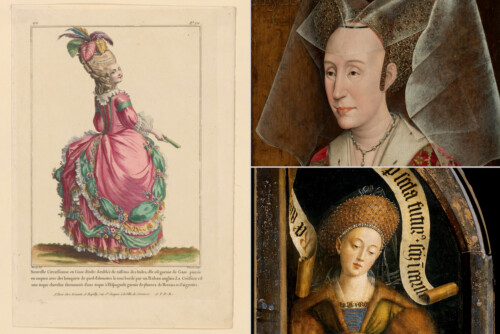Isabel of Portugal (1397–1471), duchess consort of Burgundy (1430–1467) and later dowager duchess, was a strong force in the cultural, political, diplomatic, and economic affairs of the Burgundian duchy. Her status inspired a monumental study of her personal history and political role, penned in 1998 by French historian Monique Sommé.1 Sommé’s and others’ thorough erudition and attention to detail might suggest that all has been said about Isabel; however, her multifaceted impact continues to encourage inquiry.2 While Isabel’s roles in Burgundian affairs ostensibly link her to powerful men – first to her husband Duke Philip the Good and then to her son Duke Charles the Bold – her connections to women – from nieces and daughters-in-law to ladies-in-waiting – and the place that other women had in her life as models, mentors, and spiritual guides call for further examination. Charity Cannon Willard’s 1996 essay on Isabel as patron of the arts provided the first insights on this very question.3 In this essay, I will further show that different levels of women’s community define Isabel’s life and broaden the understanding of “community” among late medieval and early modern women. Isabel supported the foundation of religious orders and buildings and forged political alliances with other women, activities shared by many aristocratic women across medieval and early modern Europe. The two most recognizable forms of community among women at the time thus were based either on religious congregations or on their immediate entourages and within their extended families and their allies. The notion of community – as a form of collective belonging that Isabel was also part of – can, however, be envisaged in less obvious, concrete, ways, as not bound to one location, time, or set of family ties, but as a more diffuse set of networks and connections across generations and geographical space. This form of women’s community mainly stemmed from shared devotional inclinations, sensibilities, and textual practices that included collecting and reading,4 and created female genealogies of readers, writers, patrons, saints, and worshippers. Scholars have coined various terms to refer to similar types of implied community; thus, Andrea Pearson, following Felicity Riddy, discusses “women’s reading communities” and adds her own term “women’s viewing communities,” and Bert Roest, in relation to Collettine authorship, speaks of that community’s “strong commemorative literary culture.”5 While fully satisfactory terminology to characterize such communities remains elusive, we might nonetheless fruitfully view their reach as considerably exceeding their limited visibility.
Isabel was the daughter of King João I of Portugal and his queen, Philippa of Lancaster; she was thus the cousin of the Lancastrian king of England Henry VI and the niece of the powerful Cardinal of Winchester. She and her siblings belonged to the Portuguese Ínclita Geração (illustrious generation) and she remained loyal to the most hapless of her brothers, Dom Pedro da Coimbra, and his offspring. Isabel was well-educated and trained in management, financial and organizational skills, and the complexities of governing.6 Her correspondence, albeit carried out through professional secretaries, indicates varying fluency in Portuguese, French, Spanish and Latin, and perhaps some Flemish.7 At age thirty three, she became the third wife of Philip the Good (r. 1419–67), reputedly the richest prince in the West, a descendant of the Valois royal family through Duke Philip the Bold (r. 1364–1404), brother to King Charles V (r. 1364–80). Burgundy’s Valois dukes, seeking to increase its wealth, strategic power, and independence vis-à-vis the kings of France and England, were caught between conflicts with France over territorial expansion and with England due to competing economic interests in the wool trade in the duchy’s Flemish lands. As Wim Blockmans and Walter Prevenier point out, Philip the Good’s marriage to Isabel on 7 January 1430, marked by a week of festive extravaganza, was to be considered “a sign of the survival of the Burgundian-English affinity,” even as Duke Philip strove to remain “aloof from the Anglo-French conflict” and to create “a unified, self-supporting state ruled by a prestigious dynasty, that the people of Europe would have to respect, one with its own cultural identity, acknowledged as new and original.”8
Until 1477, fifteenth-century Burgundy encompassed Lotharingia, Brabant, Limburg, Flanders, Artois and the Burgundy palatine, Hainaut, Holland, Zeeland, Frisia, and Namur, Salins, and Malines – an impressive enumeration that not only the duke, but also Isabel, used in many letters.9 As Philip the Good’s reign waned, Burgundy’s collision course with French interests grew. Long-standing hostilities with the dukes of Lorraine and the Swiss Cantons led to the crushing defeat of Isabel and Philip’s son, Duke Charles the Bold (r. 1467–77), at the battle waged below Nancy. King Louis XI of France (r. 1461–83) immediately invaded and wrought havoc in the Low Countries and in the Western border of Burgundy. The reign of Charles’s heir, duchess regnant Mary of Burgundy (r. 1477–82), was brief and fragile, subject to continuous French assault and intrigue.
Isabel had fully embraced the Burgundian pro-English alliance manifest in her marriage to Philip. During his reign, and then that of their son Charles, she successfully maneuvered rapprochement with England by conducting many complex negotiations over trade and diplomatic incidents. Albeit authoritarian and philandering, Philip trusted his consort’s skills as a diplomat, negotiator, and sharp financial advisor. He relied on her to broker the fragile peace of Arras with France, to conduct many negotiations with the burghers and cities of his realm, and to oversee countless minute financial details pertaining to municipal accounts and to property and building maintenance. Isabel also meticulously managed her son Charles’s financial affairs from 1462 to 1465, overseeing the expenditures and reports of his accountants and at times challenging them.10 Her activities, while notable, were not necessarily astonishing, to follow Eric Bousmar’s theory of the “elasticity” of gender roles in Burgundy.11
In 1457, Isabel retired from court life to her château of la Motte-au-Bois in the nearby Nieppe forest to practice devotion and eschew courtly splendor. Given that her husband Philip was still alive, this was a remarkable step. Sommé states that Isabel had carefully prepared this retreat, yet contemporary chroniclers attributed it to her husband’s persisting anger towards her after his clash with their son Charles in January 1457, an interpretation that has endured in much modern writing. Thus, Isabel was described as powerless following the illness of their son; Chastellain intimated that, had Charles died, Isabel would have been sent back to Portugal, aging, impoverished, and marginalized.12 The chronicler Jacques du Clercq also claimed that Isabel “feit fere religion de grises seurs … en ung lieu nommé la Motte-au-Bois … et illecq s’alla tenir, menant vie de devotion” (founded a a religious [order] of Gray Sisters … in a place named la Motte-au-Bois … and there she went to stay, leading a life of devotion).13 Yet the reality was more complex; while Isabel did found a number of Gray Sisters’ houses, la Motte-au-Bois was her private residence, in which she founded a hospital for older women and a dispensary where she personally tended to the sick with the assistance of local Gray Sisters, an order that did not confine women to the convent at all times but allowed them this sort of outside activity. The residence was part of a land gift from the duke right after their wedding, and had a domestic staff of about thirty at the time of the duchess’s death.14 Thus, Isabel drew around herself a community based on women attendants and confidants, but also comprising Gray Sisters and the women in their care, and she lived in retreat from court life, not in isolation. She received many visits, in particular from Charles, and kept up a correspondence, employing three secretaries in her household.15 She also emerged from her retreat on many occasions, both familial and official. Isabel’s retreat challenged the familiar gender scripts that restricted women’s withdrawal from public life only to widows, and the cultural parameters of a society deeply invested in the ostentatious display of wealth. The largely homosocial community that Isabel fostered around her in those years was very different from the Burgundian court women’s culture of honor, where women’s identity was based on etiquette and social preeminence.16
- Monique Sommé, Isabelle de Portugal, duchesse de Bourgogne: Une femme au pouvoir au XVe siècle (Villeneuve d’Ascq [Nord]: Presses Universitaires u Septentrion, 1998). This indispensable work nonetheless devotes limited space to Isabel in relation to other women (see 261–8, 357–63, 451–78), and does not broach a notion of women’s community. Sommé also published a number of articles on various aspects of Isabel’s life. Her place in religious politics was studied by Werner Schulz, Andreaskreuz und Christusorden: Isabelle von Portugal und Der burgundische Kreuzzug (Universitätsverlag: Freiburg, Switzerland, 1976), and her iconography was detailed in Claudine Lemaire and Michele Henry, eds., Isabelle de Portugal, duchesse de Bourgogne, 1397–1471, Catalogue; étude iconographique: Anne Rouzet (Bruxelles: Bibliothèque royale Albert 1er, 1991). Portuguese scholars have also written on her, focusing on her relationship to the Portuguese Crown and the presence of Portugal in Burgundian affairs. [↩]
- My first interest in and study of Isabel of Portugal was in the context of a project on the role of head coverings and textiles in the lives of women in Burgundy-Flanders from 1430 to 1530 and their impact on the region’s culture. [↩]
- Charity Cannon Willard, “The Patronage of Isabel of Portugal,” in The Cultural Patronage of Medieval Women, ed. June Hall McCash (Athens, GA: University of Georgia Press, 1996), 306–20. [↩]
- For the growing role of women as collectors and readers of books in informing women’s piety, see Susan Groag Bell, “Medieval Women Book Owners: Arbiters of Lay Piety and Ambassadors of Culture,” Signs 7, no. 1 (Summer 1982): 742–68. [↩]
- Andrea Pearson, Envisioning Gender in Burgundian Devotional Art, 1350–1530 (Burlington: Ashgate, 2005), 43, 51; Bert Roest, “A Textual Community in the Making: Collettine Authorship in the Fifteenth Century,” in Seeing and Knowing: Women and Learning in Modern Europe 1200–1550, ed. Anneke Mulder-Bakker (Turnhout: Brepols, 2004), 163–80. The quotation concerns an exchange of letters between Catherine Rufine and Sister Marie de Berghes as part of the formation of a “collective cultural memory by the sisters.” [↩]
- Schulz, Andreaskreuz, 62–6. [↩]
- Sommé, Femme au pouvoir, 323–8. [↩]
- Wim Blockmans and Walter Prevenier, Promised Lands: The Low Countries under Burgundian Rule, 1369–1530, trans. Lizabeth Fackelmans (Philadelphia: University of Pennsylvania Press, 1999), 73. [↩]
- Monique Sommé, ed., La Correspondance d’Isabelle de Portugal, duchesse de Bourgogne, 1430–1471 (Ostfildern: Thorbecke, 2009); see letters 4, 5, 8, 10, 11, 13, 14–19. [↩]
- Monique Sommé, “Une Mère et son fils: Isabelle de Portugal, après son départ de la cour (1457–1471), et Charles le Téméraire,” in Autour de Marguerite d’Ecosse, eds. Geneviève Contamine and Philippe Contamine (Paris: H. Champion, 1999), 109–11. [↩]
- Eric Bousmar, “Neither Equality nor Radical Oppression: The Elasticity of Women’s Roles in the Late Medieval Low Countries,” in The Texture of Society: Medieval Women in the Southern Low Countries, eds. Ellen M. Kittell and Mary Suydam (New York: Palgrave Macmillan, 2004), 109–27. [↩]
- Sommé, “Mère et fils,” 105. [↩]
- Jacques du Clercq, “Mémoires de 1448 à 146,” in Choix de chroniques et mémoires sur l’histoire de France, ed. J.A.C. Buchon (Paris: Auguste Desrez, 1838), 2: 100. [↩]
- Sommé’s study of the accounts of Isabel’s household notes for instance that twenty-four to twenty-five ladies plus associated personnel received payment in her service between 1445 and 1459; Sommé, Femme au pouvoir, 263. At times, before her retreat, the duchess might have had a female entourage of as many as forty women who followed her everywhere, including during her missions. [↩]
- Sommé, “Mère et fils,” 103. [↩]
- Susan Broomhall, “Gendering and the Culture of Honour at the Fifteenth-Century Burgundian Court,” in Women, Identities, and Communities in Early Modern Europe, eds. Stephanie Tarbin and Susan Broomhall (Burlington: Ashgate, 2009), 181–94. [↩]




